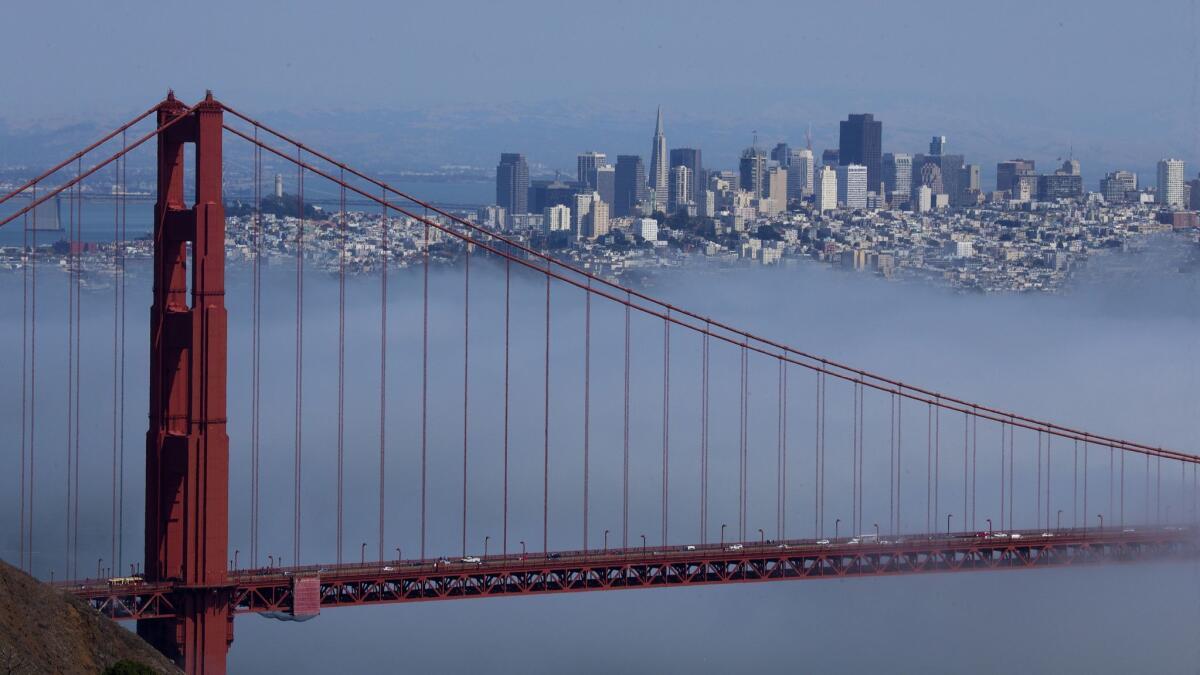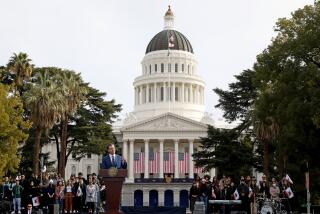What to watch for in California’s primary Tuesday

- Share via
Polls close across California at 8 p.m. Tuesday, marking the end of one of the state’s most unconventional primary elections. Simply put, there has been a lot to watch.
Although the top-two primary has been in effect since 2012, its impact has never been more consequential. The system, which awards one spot on the November ballot to only the two candidates in each race with the highest number of votes, has made national headlines for its potential effect on the races for governor, U.S. Senate and several key races for the U.S. House.
As the returns start to come in, a few snippets of electoral data are worth watching closely to better understand the story of this political season in the Golden State.
When it comes to voter turnout, it’s Los Angeles vs. San Francisco
Few elections in recent times have felt more like a contest between California’s iconic cities. And with good reason: The leading Democratic candidates for governor — Antonio Villaraigosa and Lt. Gov. Gavin Newsom — count their time as mayors of Los Angeles and San Francisco, respectively, as significant qualifications for the job of governor.
Villaraigosa began with a significantly larger electoral base than Newsom. There are 5.1 million registered voters in Los Angeles County, one of the largest constituencies in the nation. But turnout here often is much lower than voter participation in San Francisco and the neighboring (and overwhelmingly Democratic) Bay Area counties. The discrepancy between the two metropolitan areas is one reason Northern California politicians have done so well in statewide elections.
Complete California primary election coverage »
And so a key question is how many L.A. County voters show up. No primary election for governor in the last two decades has seen more than 38% of its voters cast a ballot, a percentage routinely topped in Newsom’s home territory to the north.
Recent polling in the race has shown no real dominance in Los Angeles by Villaraigosa, who left the mayor’s office in 2013. (Another major candidate, state Treasurer John Chiang, also hails from the Los Angeles region.) Newsom, by comparison, seems to be doing well in the Southland in recent surveys.
There’s another X-factor to consider, too: Voter turnout in San Francisco could be especially high Tuesday due to a hotly contested mayor’s race.
Republicans are more reliable voters in nonpresidential primaries. Will that trend hold?
As election day arrives, the ballots cast by mail and already in the hands of elections officials tell a fascinating story: a higher percentage have been cast by Republicans relative to the GOP’s share of the registered electorate.
Through late Monday, Republicans had cast about 34% of the state’s absentee ballots submitted while representing only 25% of California’s registered voters.
Simply put, no single part of a candidate’s election strategy is more important than turning out like-minded voters. Democrats may stumble if Republicans are more motivated to show up.
This is especially true in California’s battleground congressional races. The higher the GOP turnout, the more likely the party can mute some of the anger about President Trump that Democrats are counting on to move some of these seats into their column. Another wild card is whether unaffiliated “independent” voters see a reason to show up in numbers consistent with their growing dominance in voter registration.
California’s ballots won’t all be counted quickly, and that’s normal »
How many statewide races will voters simply skip, and how would that affect the rest of this political season?
When voters don’t know enough about the list of candidates in any given race, or just don’t see a favorite, they skip that contest. That’s been more of a noteworthy point of reference in the era of the top-two primary; there are 32 candidates for the U.S. Senate in this election, and there were 34 in the primary in 2016.
Republicans have no official standard-bearer in the Senate race, which raises the question of whether some GOP voters may simply move on to the next page of the ballot. Or in races that have garnered little attention — from lieutenant governor to state insurance commissioner — there could easily be fewer total votes cast. This could also be true of the five statewide ballot propositions, few of which have generated any noticeable politicking.
The political potency of the gas tax could lead to the first legislative recall in 23 years
Voters in the state’s 29th Senate District will provide the first real glimpse into one of the California Republican Party’s key strategies for surviving the 2018 election cycle. There, the political fate of a freshman legislator, Sen. Josh Newman (D-Fullerton), is on the line.
While his term is supposed to run through 2020, Newman is the subject of a recall election. Voters in the district, which stretches from Anaheim to Diamond Bar, will be asked two questions: Should Newman be removed from office and, if so, which of six replacement candidates should succeed him in Sacramento?
Recalls rarely succeed; the last legislator removed from office was Doris Allen, who represented Orange County communities not that far from Newman’s home until she was ousted in 1995. Allen had cut a political deal to become Assembly speaker, but one that nominally kept Democrats — led by the iconic former Speaker Willie Brown — from losing their power.
Newman’s recall election also is highly partisan. Other than winning a seat in 2016 that had previously been held by a Republican, the special election is all about California’s recent gas tax increase, part of a $52-billion transportation plan for which Newman voted.
Republicans also financed a signature campaign to place a full repeal of the gas tax on the November ballot, which will probably qualify for the fall election in the next few days. If they succeed in giving Newman the boot, some political watchers think it could help GOP incumbents in a few regions of the state hang on to their jobs.
For the political pulse of California, keep an eye on tiny San Benito County
Its name dates back to the decision by a Franciscan missionary to name a local river in honor of St. Benedict, the Christian patron saint of marriage. And for some two decades, San Benito County has been a faithful political spouse to just about every major statewide election — where one goes, so goes the other.
Why the county, running to the east and south of Salinas, would be such a good bellwether for California elections is unclear. Even so, its political affiliations — 46.6% Democratic, 26.9% Republican and 22% unaffiliated — are within arm’s reach of statewide registration. A local business leader told The Times in 2006 that the community was small enough for its citizens to avoid bitter political partisanship. But it’s also a part of the state where urban trends — being just south of Silicon Valley — mingle with coastal and agricultural priorities.
If history is any guide, not only will San Benito’s voters pick the top candidates in statewide races and ballot measures but will report margins of victory that are very close to the percentages reported for the state as a whole.
Follow @johnmyers on Twitter, sign up for our daily Essential Politics newsletter and listen to the weekly California Politics Podcast
More to Read
Get the L.A. Times Politics newsletter
Deeply reported insights into legislation, politics and policy from Sacramento, Washington and beyond. In your inbox three times per week.
You may occasionally receive promotional content from the Los Angeles Times.











